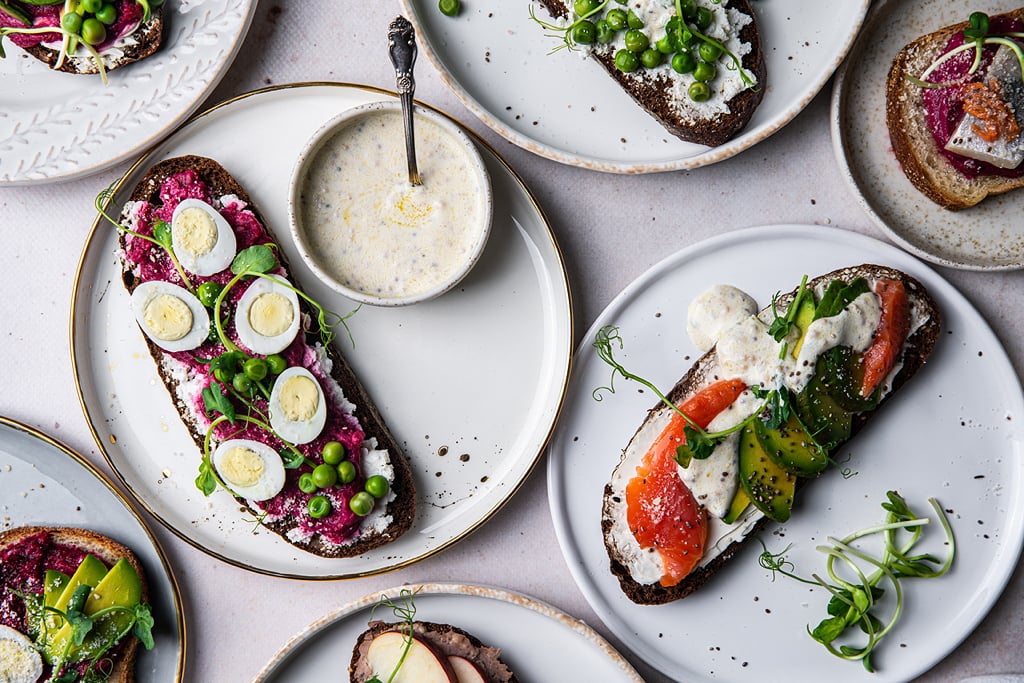
Trend Insights: Scandi Café Culture
Expert insights on Scandinavian influences and opportunities
Trend Insights: Scandi Café Culture
Expert insights on Scandinavian influences and opportunities
Scandinavian cuisine is like Mediterranean food for Northern Europe. Scandinavian countries highlight whole ingredients, their portions are on the smaller side, they incorporate a lot of produce, and they move with the seasons.
—MAEVE WEBSTER, President, Menu Matters
Smørrebrød is becoming more popular and demonstrates how the coffee and snack break could apply to U.S. menus. It is a great add-on for most brands, as they can apply their signature touch to these bites without the need for additional menu SKUs.
—JASON HERNANDEZ, Chef/Founder, Blade & Tine Culinary Consulting
This is what we’re striving for in hospitality today: offering an inviting experience that brings people together. Leveraging Scandi café culture offers us a great opportunity to create a moment in the day for friends to come in and have a piece of pie and warm cup of tea or coffee. It doesn’t have to be an over-the-top experience. This trend reminds us that it can be simple and genuine. We can look at interpreting fika for our brands as a way of forging deeper emotional connections with our guests.
—MINDY ARMSTRONG, VP of Menu Innovation, Ascent Hospitality Management
Scandinavian food is known for showcasing foraged foods and preserved fish, both of which have become wildly popular in the last couple of years. Smørrebrød is a fabulous way for chefs to serve a familiar, approachable and comforting dish, the humble sandwich, in more artistic and eye-appealing presentations and nutrient-dense carbs that come from hearty rye bread. The ability for chefs to showcase local ingredients within the Scandinavian cuisine umbrella, such as in this New Mexico Green Chile Smørrebrød, coupled with the fact that diners have become more familiar with foraged and healthful foods such as elderberry, is what will continue to drive this trend.
—REBECCA PEIZER, Chef/Founder, All Things Culinary
Their traditions of pickling, preserving and fermenting are interesting to chefs and consumers here. It’s a snack-focused culture with appealing drinks. Then there’s that togetherness, calm and taking time for yourself—all of which consumers crave today.
—CLAIRE CONAGHAN, Trendologist/Associate Director of Publications, Datassential
Scandinavian cuisine is like Mediterranean food for Northern Europe. Scandinavian countries highlight whole ingredients, their portions are on the smaller side, they incorporate a lot of produce, and they move with the seasons.
—MAEVE WEBSTER, President, Menu Matters
Smørrebrød is becoming more popular and demonstrates how the coffee and snack break could apply to U.S. menus. It is a great add-on for most brands, as they can apply their signature touch to these bites without the need for additional menu SKUs.
—JASON HERNANDEZ, Chef/Founder, Blade & Tine Culinary Consulting
This is what we’re striving for in hospitality today: offering an inviting experience that brings people together. Leveraging Scandi café culture offers us a great opportunity to create a moment in the day for friends to come in and have a piece of pie and warm cup of tea or coffee. It doesn’t have to be an over-the-top experience. This trend reminds us that it can be simple and genuine. We can look at interpreting fika for our brands as a way of forging deeper emotional connections with our guests.
—MINDY ARMSTRONG, VP of Menu Innovation, Ascent Hospitality Management
Scandinavian food is known for showcasing foraged foods and preserved fish, both of which have become wildly popular in the last couple of years. Smørrebrød is a fabulous way for chefs to serve a familiar, approachable and comforting dish, the humble sandwich, in more artistic and eye-appealing presentations and nutrient-dense carbs that come from hearty rye bread. The ability for chefs to showcase local ingredients within the Scandinavian cuisine umbrella, such as in this New Mexico Green Chile Smørrebrød, coupled with the fact that diners have become more familiar with foraged and healthful foods such as elderberry, is what will continue to drive this trend.
—REBECCA PEIZER, Chef/Founder, All Things Culinary
Their traditions of pickling, preserving and fermenting are interesting to chefs and consumers here. It’s a snack-focused culture with appealing drinks. Then there’s that togetherness, calm and taking time for yourself—all of which consumers crave today.
—CLAIRE CONAGHAN, Trendologist/Associate Director of Publications, Datassential







